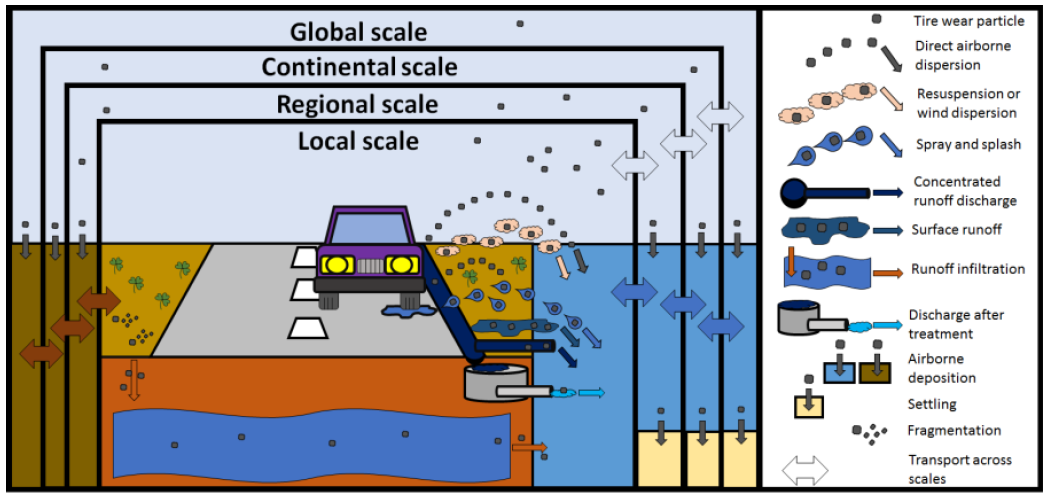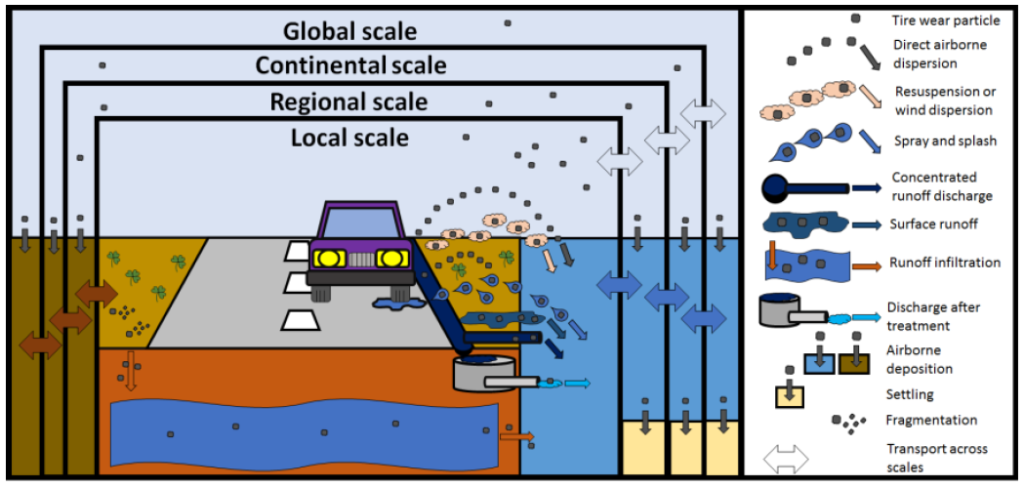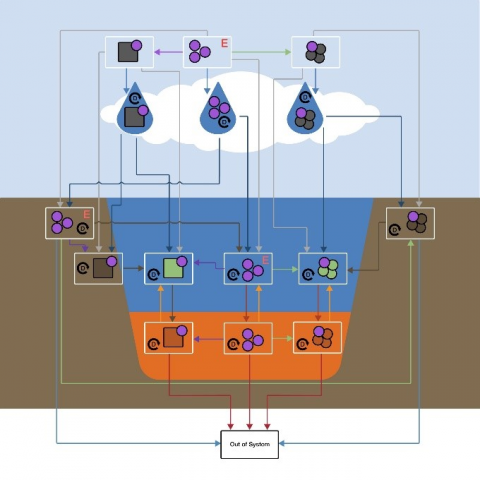
From tyres to our body: how can microparticles travel so far? How to model their dispersion to prevent and anticipate such pollutions?
Microplastics have been recently (March 22, 2022) discovered in the blood of a human for the first time which can cause numerous damages to biological organisms. Such microparticles can now be found almost everywhere in the globe. It has become a major public health and environmental issue.
Tyres are one of the sources of microplastics in the environment. Indeed, they lose roughly 1-1.5kg in weight during their service life. Over 90% of this wear is deposited as microplastics on the road, in road-side soil, or transported with run-off water through water pathways to deposit in streams, lakes and the sea. The remaining fraction—mostly very fine particles—becomes airborne. Studies have shown that tyre wear particles (TWP) are present in all environmental compartments including air, water, soils/sediment, and biota [1].

One of the goals of the LEON-T project is to take a transversal approach to the study of TWP generated by tyres: from the sources (objective 1 and objective 2) to modeling their dispersion in the environment (objective 3) to prevent such pollutions.
Most of the existing fate modelling studies [2, 3] have focused on the aquatic compartment, excluding ground, soil and air compartments, though roadside soils and agricultural soils are expected to receive significant amounts of TWP. The projects NanoFASE and NanoNextNL have led to an extended fate model covering all compartments of regulatory interest (air, water, sediment and soil)— SimpleBox4nano (SB4N) — aimed at screening exposure levels of nanomaterials. However, this model does require improvement on how it handles certain fate processes (fragmentation, chemical transformation) in order to accurately estimate particle concentrations especially in sink compartments such as soil and sediment.

Limited data on tyre-generated microplastics in water bodies and soil has become available in recent years [4,5], but the majority lacks quality signaling, a need to improve sampling, sample treatment and final detection. Though biodegradation of tyre-generated microplastics in soil will be slow, other physical and chemical breakdown processes will influence soil fixation, resuspension and wash-off and thereby the fate of such TRWP. ISO/TS 22687 (2018) describes accelerated aging and weathering of TWP in a laboratory setting with controlled UV radiation, temperature and humidity, however the methodology including endpoints regarding physical and chemical changes of TWP are not defined yet.
Several methodologies for sampling, sample treatment (e.g. density separation, chemical/enzymatic treatment) and analysis (e.g. thermo-analytical, additive-markers) exist, but to date there are no harmonized methods available. Recently a framework for assessing the environmental fate of Tyre Road Wear Particles (TRWP; ISO/TS 22687, 2018) and a framework for physical and chemical characterization of TRWP (ISO/TS 22640, 2018) were developed—but do not give details of methods.
LEON-T will advance the state of the art on field measurements of TRWP in the following ways:
- Inventory and assessment of existing field data on the presence and quantities of TWP and other microplastics in environmental compartments to gain insight in the contribution of TWP to microplastic distribution in the environment and to identify data gaps to develop an effective strategy for additional field measurements.
- Further development of sequential micro/nano filtration for fractionation of TWP and microscopic techniques in combination with particle imaging and elemental/spectroscopic detection for TWP particle quantification and characterization: size, shape, effective density, composition in environmental matrices.
- Chemical transformation and fragmentation rates of TRWP will be experimentally determined with accelerated aging and weathering tests in order to quantify the kinetics of currently uncertain fate processes, linked to the different material compositions of tyres.
- Distinguish between Tire Wear (TW) and Road Wear (RW) within a TRWP (Tyre and Road Wear Particle).
Apart from improvements in field measurements, LEON-T will advance the SB4N model to include a separate “roadside” compartment, and by modelling the fragmentation of micro to nano particles. The field measurement data gathered will allow improved calibration and parameterization of SB4N. We will validate the improved SB4N model by comparing estimated with measured values of microplastics in a number of expected “hotspots”. Once validated, the model can be used to provide insight into the most effective policy options depending on the protection target (e.g. roadside soil vs. natural soil).
[1] Wik, A. and Dave, G., (2009). Occurrence and effects of tire wear particles in the environment–A critical review and an initial risk assessment. Environ. Pollut. 157(1), 1-11. DOI: 10.1016/j.envpol.2008.09.028
[2] Unice, K. M., et al. (2019). Characterizing export of land-based microplastics to the estuary-Part I: Application of integrated geospatial microplastic transport models to assess tire and road wear particles in the Seine watershed. Sci.Total.Environ. 646. 1639-1649. DOI: 10.1016/j.scitotenv.2018.07.368
[3] Besseling, E., Quik, J. T., Sun, M., and Koelmans, A. A. (2017). Fate of nano-and microplastic in freshwater systems: A modeling study. Environ.Pollut. 220(Pt A), 540-548. DOI: 10.1016/j.envpol.2016.10.001
[4] CEDR-Report (2018). MICROPROOF – Micropollutants in road run-off – Review of available measurements of organic micropollutants, microplastics and associated substances in road run-off. Deliverable 1.2
[5] CEDR-Report (2019). MICROPROOF – Micropollutants in road run-off – Measurements of organic micropollutants, microplastics and associated substances from road transport. Deliverable 6.6
